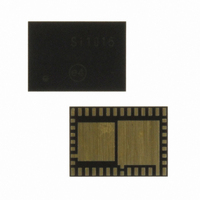SI1005-C-GM Silicon Laboratories Inc, SI1005-C-GM Datasheet - Page 256

SI1005-C-GM
Manufacturer Part Number
SI1005-C-GM
Description
IC TXRX MCU + EZRADIOPRO
Manufacturer
Silicon Laboratories Inc
Specifications of SI1005-C-GM
Package / Case
42-QFN
Frequency
240MHz ~ 960MHz
Data Rate - Maximum
256kbps
Modulation Or Protocol
FSK, GFSK, OOK
Applications
General Purpose
Power - Output
13dBm
Sensitivity
-121dBm
Voltage - Supply
0.9 V ~ 1.8 V
Current - Receiving
18.5mA
Current - Transmitting
30mA
Data Interface
PCB, Surface Mount
Memory Size
32kB Flash, 4kB RAM
Antenna Connector
PCB, Surface Mount
Number Of Receivers
1
Number Of Transmitters
1
Wireless Frequency
240 MHz to 960 MHz
Interface Type
UART, SMBus, SPI, PCA
Output Power
13 dBm
Operating Supply Voltage
0.9 V to 3.6 V
Maximum Operating Temperature
+ 85 C
Mounting Style
SMD/SMT
Maximum Supply Current
4.1 mA
Minimum Operating Temperature
- 40 C
Modulation
FSK, GFSK, OOK
Protocol Supported
C2, SMBus
Core
8051
Program Memory Type
Flash
Program Memory Size
32 KB
Data Ram Size
4352 B
Supply Current (max)
4.1 mA
Lead Free Status / RoHS Status
Lead free / RoHS Compliant
Operating Temperature
-
Lead Free Status / Rohs Status
Lead free / RoHS Compliant
Other names
336-1875-5
Available stocks
Company
Part Number
Manufacturer
Quantity
Price
Company:
Part Number:
SI1005-C-GM
Manufacturer:
Silicon Labs
Quantity:
135
- Current page: 256 of 376
- Download datasheet (3Mb)
Si1000/1/2/3/4/5
mode it will be the data to be modulated and transmitted. In RX mode it will be the received demodulated
data. Figure 23.9 demonstrates using MOSI and MISO as the TX/RX data and clock:
If the MISO pin is not used for data clock then it may be programmed to be the interrupt function (nIRQ) by
programming Reg 0Eh bit 3.
23.4.3. PN9 Mode
In this mode the TX Data is generated internally using a pseudorandom (PN9 sequence) bit generator. The
primary purpose of this mode is for use as a test mode to observe the modulated spectrum without having
to provide data.
23.5. Internal Functional Blocks
This section provides an overview some of the key blocks of the internal radio architecture.
23.5.1. RX LNA
Depending on the part, the input frequency range for the LNA is between 240–960 MHz. The LNA provides
gain with a noise figure low enough to suppress the noise of the following stages. The LNA has one step of
gain control which is controlled by the analog gain control (AGC) algorithm. The AGC algorithm adjusts the
gain of the LNA and PGA so the receiver can handle signal levels from sensitivity to +5 dBm with optimal
performance.
In the Si1002/3, the TX and RX may be tied directly. See the TX/RX direct-tie reference design available
on www.silabs.com. When the direct tie is used the lna_sw bit in Register 6Dh, TX Power must be set.
23.5.2. RX I-Q Mixer
The output of the LNA is fed internally to the input of the receive mixer. The receive mixer is implemented
as an I-Q mixer that provides both I and Q channel outputs to the programmable gain amplifier. The mixer
consists of two double-balanced mixers whose RF inputs are driven in parallel, local oscillator (LO) inputs
are driven in quadrature, and separate I and Q Intermediate Frequency (IF) outputs drive the programma-
ble gain amplifier. The receive LO signal is supplied by an integrated VCO and PLL synthesizer operating
between 240–960 MHz. The necessary quadrature LO signals are derived from the divider at the VCO out-
put.
23.5.3. Programmable Gain Amplifier
The programmable gain amplifier (PGA) provides the necessary gain to boost the signal level into the
dynamic range of the ADC. The PGA must also have enough gain switching to allow for large input signals
to ensure a linear RSSI range up to –20 dBm. The PGA has steps of 3 dB which are controlled by the AGC
algorithm in the digital modem.
256
MOSI
MSIO
NSS
SPI output
SPI input
don’t care
don’t care
Figure 23.9. Microcontroller Connections
SPI output
command
SPI input
TX on
MOD input
Data CLK
TX mode
Output
Rev. 1.0
SPI output
command
SPI input
TX off
don’t care
don’t care
SPI output
command
SPI input
RX on
Data output
Data CLK
Output
RX mode
SPI output
command
SPI input
RX off
Related parts for SI1005-C-GM
Image
Part Number
Description
Manufacturer
Datasheet
Request
R
Part Number:
Description:
SMD/C°/SINGLE-ENDED OUTPUT SILICON OSCILLATOR
Manufacturer:
Silicon Laboratories Inc
Part Number:
Description:
Manufacturer:
Silicon Laboratories Inc
Datasheet:
Part Number:
Description:
N/A N/A/SI4010 AES KEYFOB DEMO WITH LCD RX
Manufacturer:
Silicon Laboratories Inc
Datasheet:
Part Number:
Description:
N/A N/A/SI4010 SIMPLIFIED KEY FOB DEMO WITH LED RX
Manufacturer:
Silicon Laboratories Inc
Datasheet:
Part Number:
Description:
N/A/-40 TO 85 OC/EZLINK MODULE; F930/4432 HIGH BAND (REV E/B1)
Manufacturer:
Silicon Laboratories Inc
Part Number:
Description:
EZLink Module; F930/4432 Low Band (rev e/B1)
Manufacturer:
Silicon Laboratories Inc
Part Number:
Description:
I°/4460 10 DBM RADIO TEST CARD 434 MHZ
Manufacturer:
Silicon Laboratories Inc
Part Number:
Description:
I°/4461 14 DBM RADIO TEST CARD 868 MHZ
Manufacturer:
Silicon Laboratories Inc
Part Number:
Description:
I°/4463 20 DBM RFSWITCH RADIO TEST CARD 460 MHZ
Manufacturer:
Silicon Laboratories Inc
Part Number:
Description:
I°/4463 20 DBM RADIO TEST CARD 868 MHZ
Manufacturer:
Silicon Laboratories Inc
Part Number:
Description:
I°/4463 27 DBM RADIO TEST CARD 868 MHZ
Manufacturer:
Silicon Laboratories Inc
Part Number:
Description:
I°/4463 SKYWORKS 30 DBM RADIO TEST CARD 915 MHZ
Manufacturer:
Silicon Laboratories Inc
Part Number:
Description:
N/A N/A/-40 TO 85 OC/4463 RFMD 30 DBM RADIO TEST CARD 915 MHZ
Manufacturer:
Silicon Laboratories Inc
Part Number:
Description:
I°/4463 20 DBM RADIO TEST CARD 169 MHZ
Manufacturer:
Silicon Laboratories Inc











